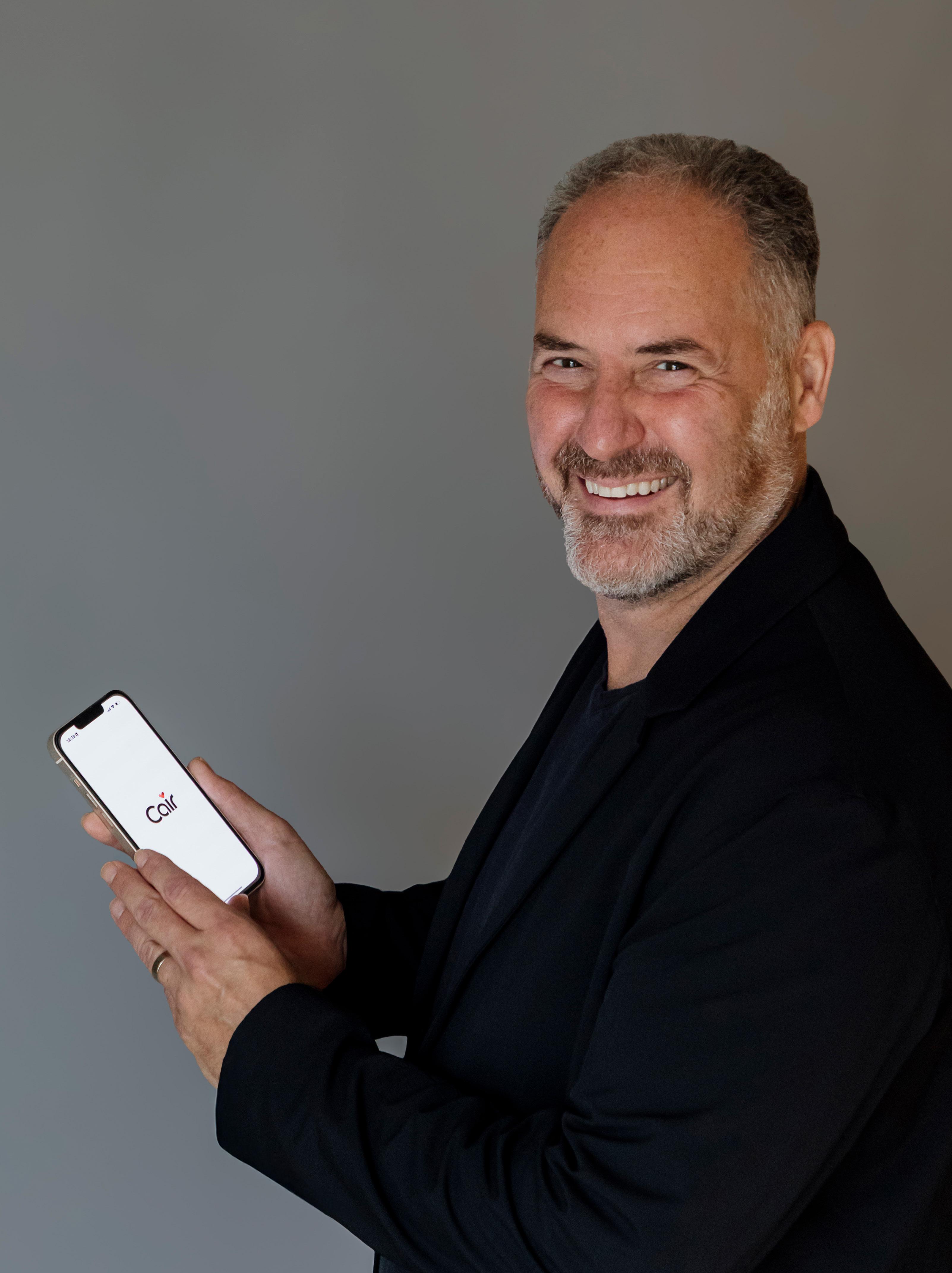

How Steve Jobs Changed Dentistry Forever
by Dr. Bryan Laskin
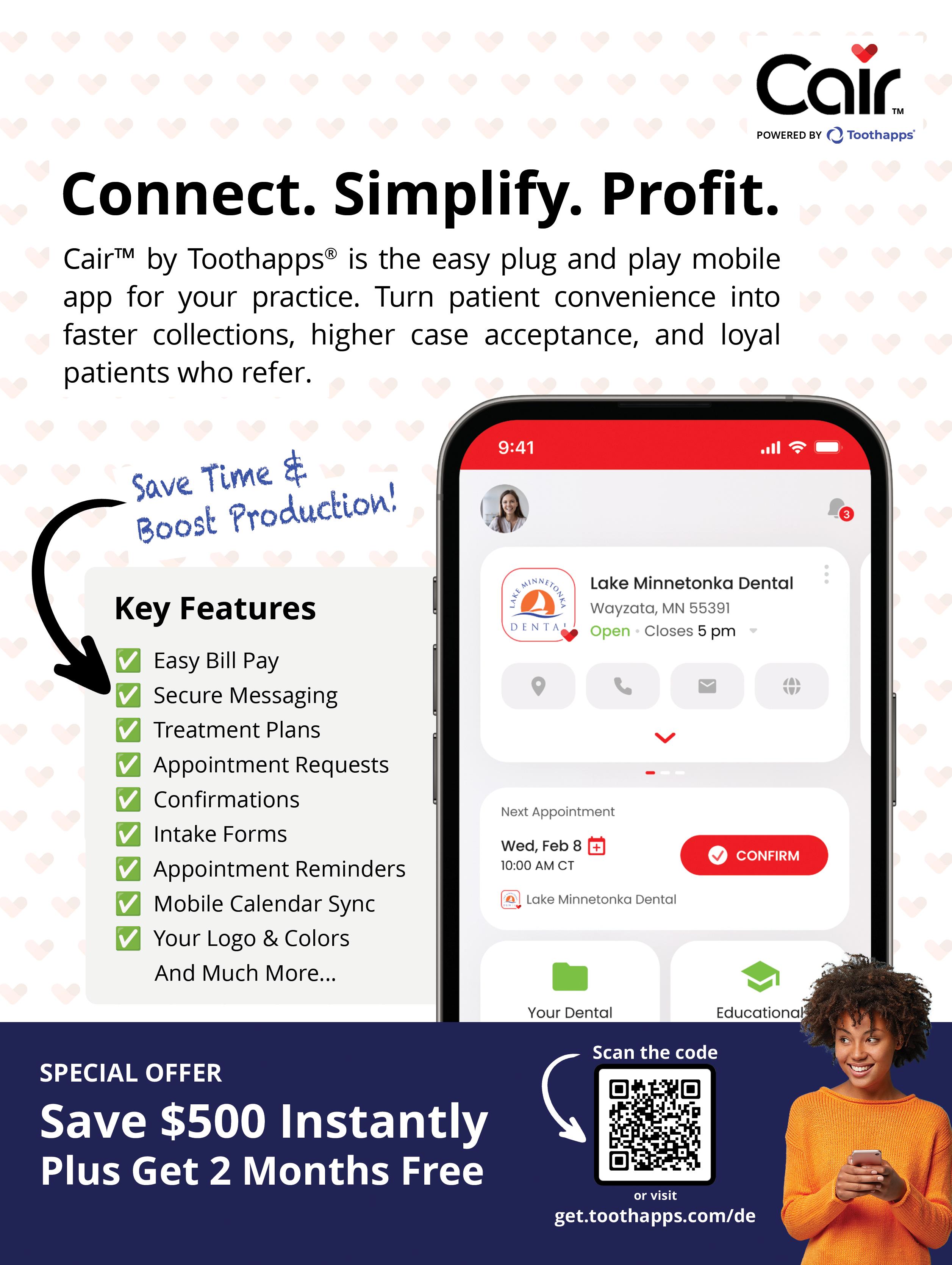

November 13-15, 2025


Welcome
Dentistry is evolving faster than ever. The leaders who will define the next era are not just those who master clinical innovation, they are the ones who embrace vision, technology, and human-centered care, all while cultivating community.

Fall 2025
Editor & Publisher
Anne M. Duffy, CEO, RDH
Assistant Editor Karla Moreno
Project Manager
Tari Sixpence
Website
Bhakti Kulmala
Layout and Design
Brian Rummel
Cover Photo
Andrea White
Editorial Board
Mary Fisher-Day
Dr. Dirk Fleischman
Dr. Sharon Parsons
Dr. Isabel Rambob
Dr. David Rice
Travis Rodgers
Barb Stackhouse
Dr. Lucas Shapiro
Dr. Tom Snyder
Ryan Vet
Fall 2025 Contributors
Bennett Blakeman
Dr. Josh Brower
Crystal Eudy
Lauren Kearl
Dr. Bryan Laskin
homas Passalacqua
Cory Pinegar
Dr. Alan Stern
Angela Davis-Sullivan
Amy Wood
Editorial Office
8334 Pineville Matthews Rd Ste. 103-201
Charlotte, NC 28226
704/953-0261
Fax 704/847-3315
anneduffyde@gmail.com
Send materials to:
Dental Entrepreneur Magazine
8334 Pineville Matthews Road Ste. 103-201 Charlotte, NC 28226

In this issue, we’re thrilled to feature Dr. Bryan Laskin, Co-Founder and CEO of Toothapps®, Cair™, and the Dental Standards Institute. His patient-first approach reminds us that innovation is not about gadgets, it’s about creating systems that simplify, humanize, and modernize the patient experience. Through his leadership, Dr. Laskin continues to redefine what’s possible in digital dentistry by building bridges between technology, communication, and care.
His work, including our upcoming collaboration on the 2026 DeW Life Retreat app, illustrates how technology can empower both patients and providers, and, in our case, an entire community of women in dentistry. With the support of Dr. Laskin and his visionary team, DeW Life is taking a bold step forward in how we connect, engage, and celebrate one another. Together, we’re creating tools that will elevate how members experience our retreats, expand networking opportunities, and strengthen the meaningful relationships that make DeW so unique. It’s more than an app, it’s the next evolution of how we grow, learn, and lead together.
We also explore the transformative potential of AI in dentistry with Amy Wood’s insightful piece on ethical, responsible integration of AI into practice management. Meanwhile, Cory Pinegar’s story of scaling Reach from a $1 startup to a 350-person team highlights the power of resilience, clarity, and building businesses that balance people and purpose. And rising stars like Dr. Kylie Schlesinger is showing us that mentorship, creativity, and community engagement are as critical to success as any clinical skill.
Clinical innovation also continues to advance. Bennett Blakeman’s article on Aquoral and xerostomia management underscores how thoughtful, patient-focused solutions not only improve care, they create differentiation and long-term impact for practices. Across these stories, one theme is clear: the future of dentistry is about connecting technology, leadership, and compassion.
At Dental Entrepreneur: The Future of Dentistry, we are committed to fostering a community where these ideas don’t just stay on the page, they come to life. Whether through retreats, mentorship, or professional collaboration, our members are building networks that amplify impact, spark innovation, and elevate patient care.
As you read this edition, I encourage you to ask yourself: How can I innovate, lead, and connect in a way that elevates both my patients and my team? The tools, insights, and inspiration are here. The moment is now. Let’s shape the future of dentistry, together.
Warmest regards,








10 AI in Dentistry: Friend, Foe, or Frenemy? by Amy Wood

16 The Man in the Gym Class by Dr. Alan Stern
6 How Steve Jobs Changed Dentistry Forever by Dr. Bryan Laskin

12 A DeW(ds) Perspective: Know Your Numbers So You Know Who You Can Be Compassionate With by Dr. Josh Brower

18 Four Strategies for Dentists to Avoid Financial Burnout by Lauren Kearl Business

22 From a $1 Startup to a 350+ Team: What I Learned From Building it the Wrong Way First by Cory Pinegar
24 Lessons From the Professionally Ambitious: Common Themes Among the Industry’s Most Dedicated Leaders by Thomas Passalacqua


27 From Dining Room Table to Nationwide: How I Built by Crystal Eudy
28 Hope Returns to Dry Mouth Care: How Aquoral’s Comeback Is Redefining Xerostomia Management and Practice Differentiation by Bennett Blakeman
32 Beyond the Chair: How Dr. Kylie Schlesinger Is Bridging Dentistry and Dialogue by Dr. Luke Shapiro, DDS
36 Beyond the Chair: How Dr. Kylie Schlesinger Is Bridging Dentistry and Dialogue by Angela Davis-Sullivan


How Steve Jobs Changed Dentistry Forever
By Dr. Bryan Laskin
THE DAY EVERYTHING CHANGED
In January 2007, Steve Jobs walked on stage in his trademark black turtleneck and held up a device that changed the world: the iPhone.
It wasn’t just a phone. It was music, communication, the internet, and a thousand other conveniences, all in the palm of your hand. Overnight, convenience stopped being optional. It became the baseline expectation for how we bank, shop, travel, and connect.
Fast-forward to today: your patients carry that supercomputer in their pocket. They order groceries with a swipe, check in for flights in seconds, even schedule vet visits through an app. Yet when they interact with most dental practices, they are still asked to:
• Wait on hold to schedule an appointment.
• Fill out clipboards of paper in the waiting room.
• Mail checks or call the office to pay a bill.
The disconnect is glaring. Dentistry has built incredible clinical technology inside the operatory. But outside of it, we are years behind. And that gap is costing practices efficiency, profitability, and most importantly trust.
SEEING THROUGH PATIENTS’ EYES
When I look back at my own success growing a practice from 800 to 8,000 square feet, sustaining 25 percent year-over-year growth for two decades, the key was simple. I stopped looking at my practice through my own eyes and started looking at it through my patients’ eyes.
It was key to growing my practices, and the software companies I launched afterwards, my first was implemented in tens of thousands of dental practices when it was acquired in 2021 and now at Toothapps.com.
That mindset became the foundation of my book, The Patient First Manifesto. The core idea is simple: innovation is not about gadgets or hype. It is about designing systems around the patient experience.
Patients never want to sit in waiting rooms filling out redundant forms. No one wants a game of phone tag with your team. They don’t want to wonder if their bill was lost in the mail.
What they want is something simple, modern, and human.
This is what Steve Jobs understood so well. He didn’t invent phones, music players, or the internet. He stripped away what

people never wanted in the first place and replaced it with something beautifully simple. Dentistry must do the same.
“It is about stripping away what patients never wanted in the first place, like paper, phone tag, and delays, and replacing it with something simple, modern, and human.”
CONVENIENCE IS THE NEW CURRENCY
Today’s patients don’t just compare your practice to the dentist down the street. They compare their experiences in your practice to Apple, Amazon, and Delta Airlines. If your systems feel outdated, they assume your care is outdated too.
Convenience is the new currency of trust. And trust drives production through case acceptance, loyalty, referrals, and, ultimately, profitability.
That is why a mobile app for your practice is no longer just niceto-have. It is the clearest way to show patients you respect their time and understand their world. A well-designed app lets them:
• Securely message your team.
• Fill out forms at home instead of in the lobby.
• Confirm or change appointments with one tap.
• Pay their bill instantly without mailing a check.
In short, it puts your practice where your patients already live: on their phone. Instead of paying expensive marketing companies to chase your patients around the internet it removes the need through a real connection.
EFFICIENCY THROUGH THE PATIENT LENS
Efficiency in dentistry is usually framed as reducing costs or squeezing in more procedures. But when you look through the patient’s eyes, efficiency means eliminating the friction they never wanted in the first place.
• Paper billing: slow, frustrating, and easy to ignore.
• Digital billing via app: instant, convenient, and patients pay faster.
• Paper intake forms: stressful, error-prone, and a terrible first impression.
• Digital intake: simple, accurate, and done on the patient’s schedule.
• Chasing dentists down the hall: wasted time and missed opportunities.
• Secure in-office messaging: seamless, professional, and leads to more same-day care.
When you strip away these old systems, everyone wins. The team gains back hours, profitability rises, and patients feel cared for rather than processed.
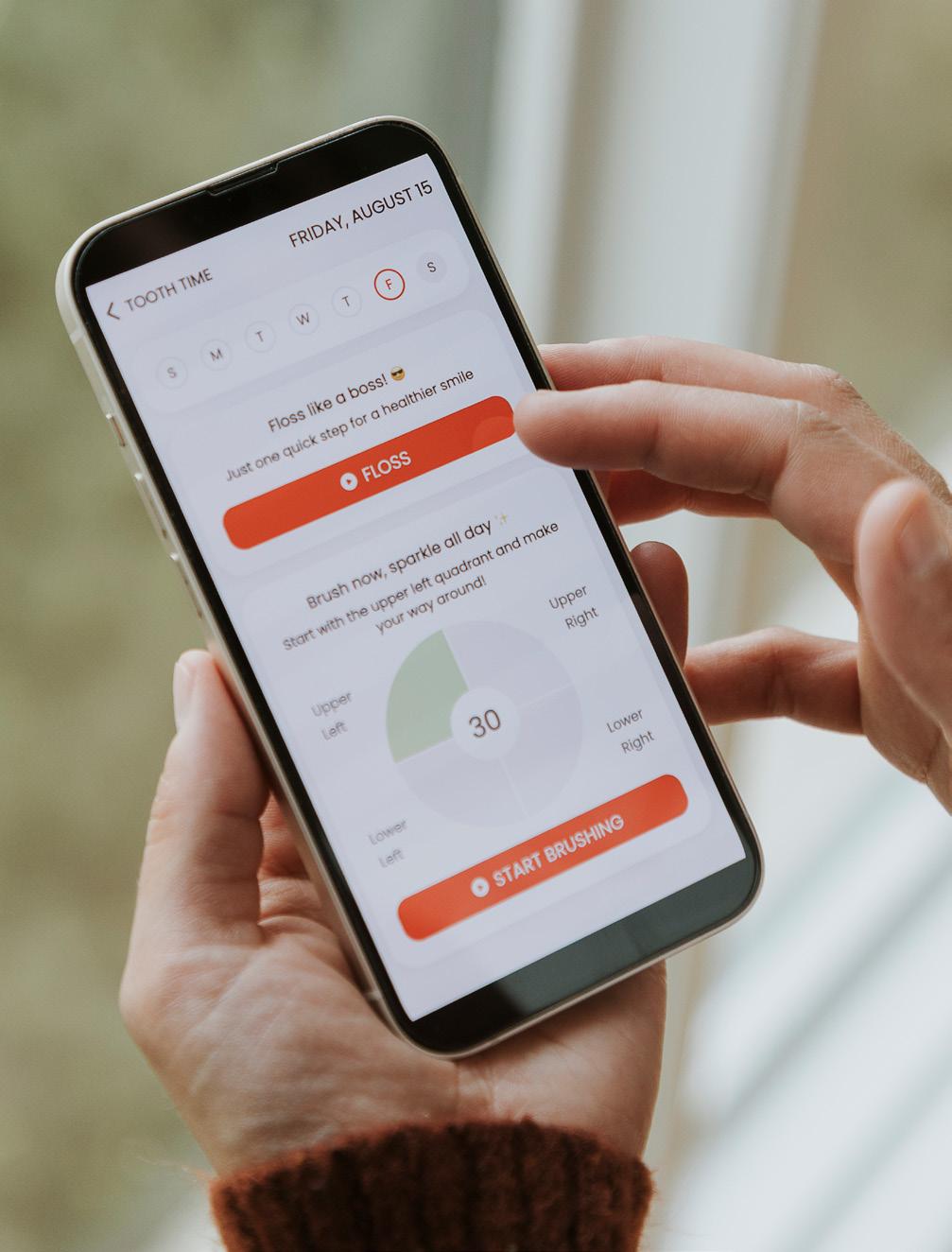
It is about stripping away what patients never wanted in the first place, like paper, phone tag, and delays, and replacing it with something simple, modern, and human.
DENTISTRY’S iPHONE MOMENT
Every industry eventually reaches a tipping point where innovation shifts from optional to mandatory. Banking, retail, and travel already had theirs. Dentistry’s moment is happening right now.
The staffing shortage means you cannot just hire your way out of inefficiency. Rising costs mean you cannot absorb the waste of outdated processes. Patients’ expectations mean you cannot lag behind the rest of the world.
The answer is not more complexity. The answer is what Steve Jobs taught us: simplify. Remove friction. Put the power in the user’s hands.
For dentistry, that means putting your practice in your patients’ pocket.
LEADERSHIP MEANS PUTTING PATIENTS FIRST
As dentists, we must think of ourselves as clinicians first. But if you own or lead a practice, you are also an entrepreneur and a
CEO. Leadership is about having the courage to ask the hard question: “Would I choose my own practice if I were the patient?”
If the answer is no, you already know what to do. Patients expect modern, mobile, convenient interactions. The practices that meet them there will thrive. The ones that don’t will lose patients quietly and steadily.
This is the central message of The Patient First Manifesto. Innovation is not about chasing every shiny gadget. It is about putting patients first: reducing friction, simplifying connection, and building trust. When you do, efficiency and profitability follow naturally.
DENTISTRY’S MOMENT IS HERE
Dentistry’s iPhone moment is here. Patients expect to interact with your practice the same way they interact with their bank, their airline, even their vet.
Imagine walking into your office and finding your team free from paperwork, your patients already prepared, and your collections up because paying a bill is as easy as buying something on Amazon. Imagine adding same-day treatment effortlessly because your team can instantly communicate.
This is not the future. It is what is possible right now.
My own success came from seeing my practice through my patients’ eyes. The next wave of success in dentistry will come to those who do the same… and who embrace the mobile-first world Steve Jobs created.
The tools are ready. The demand is there. The moment is now.
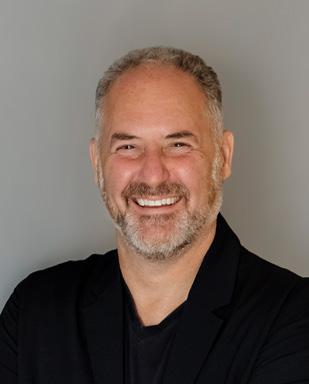
Dr. Bryan Laskin is a Minnesota dentist and tech entrepreneur on a mission to connect dentistry and empower patients through innovation and standardization. Co-Founder and CEO of Toothapps®, Cair™ and Dental Standards Institute, Dr. Laskin is the host of “The Patient First Podcast” and author of the Amazon best selling books, “The Patient First Manifesto” and “Dental Disorder”. His latest book, “Unfair Care” is was released in early October.
Social Media: LinkedIn @bryanlaskin | Facebook & Instagram @drbryanlaskin

AI in Dentistry: Friend, Foe, or Frenemy?
How dental teams can ethically and securely integrate artificial intelligence into practice management
By Amy Wood, HCISPP, CEO Copper Penny Consulting
WHERE AI IS ALREADY LIVING IN YOUR PRACTICE
You may not realize how many AI-driven tools you’re already using. Here’s a snapshot of where AI is quietly (or not-so-quietly) changing the way dental practices operate:
• X-rays and Imaging: AI assists in interpreting radiographs or providing a second opinion.
• Voice and Perio Charting: Hands-free solutions enhance efficiency—but may introduce HIPAA risks.
• Marketing and Call Analytics: AI tracks call conversions and patient behavior.
• Website Chatbots & AI Greeters: Responders convert visitors—but where does the data go?
• Auto-Scheduling & Text Responders: Patients interact with AI to book and ask questions.
• Answering Services: AI phone agents are replacing live operators.
• Claims and Insurance: AI flags, denies, or expedites claims.
• Teledentistry & Robotic Procedures: From consults to surgeries, AI is expanding.
• Salivary Diagnostics & Smile Design: New tools offer diagnostics and modeling.
• Tailored Patient Education: AI creates home care plans and explains conditions in real-time.
THE COMPLIANCE CATCH
Just because AI works fast doesn’t mean it works right. AI systems can suffer from:
• False Positives and Negatives: Misdiagnoses can carry legal and clinical implications.
• Bias: Algorithms may be trained on non-diverse datasets, resulting in flawed outcomes.
• Hallucinations: AI tools can fabricate information or sound confident about incorrect details.
Security is another issue. You must know:
• Where the data is going, living, and being stored.
• Whether the vendor is truly HIPAA-compliant, or if they just say they are..
• What third-party systems are touching your patients’ Protected Health Information (PHI).
Vendor vetting is essential. Ask tough questions about encryption, breach response plans, access control, and training. Ensure the vendor has a solid plan for when incidents happen and cyber insurance to pay for those incidents, so you don’t have to.
WHAT DOES THIS MEAN FOR YOUR TEAM?
Every smart tool changes workflows. Leaders must evaluate:
“AI has the power to streamline dental practices, but only if it’s used responsibly, ethically, and with a human-centered mindset.”
— Amy Wood, CEO, Copper Penny Consulting
• Will AI reduce or increase manual tasks?
• Does it make the team’s job easier or harder?
• Who will manage the AI tools?
• Has your team received training on using AI securely?
If your team doesn’t understand how the AI works—or blindly trusts it—you’re inviting risk. Education is key. Every team member should understand not only how to use the tool, but why certain safeguards are necessary.
A NEW KIND OF TRAINING FOR A NEW ERA
The course “AI in Dentistry: Friend, Foe, or Frenemy?” introduces the expanding AI landscape for dental teams in an accessible, engaging format.
Ideal for:
• Study clubs
• Practice team meetings
• Dental association events
• Regional and national conferences
CE credit is available. The course can be delivered live or virtually and is packed with real-world examples, case studies, and compliance checklists. Your team will walk away with a better understanding of how to assess, implement, and monitor AI solutions—without compromising ethics or security.
WANT TO LEARN MORE
To bring this course to your event or dental practice, contact us at education@copperpennyconsulting.com.
Train your team to run AI—safely, smartly, and with a compliance-first mindset.
As the CEO of Copper Penny Consulting, Amy is a nationally recognized expert in HIPAA compliance, cybersecurity, and emerging AI risks in dentistry. With a background that bridges the dental industry, regulation and common sense, she translates complex regulations into relatable, real-world strategies dental teams can actually use.

Known for her engaging teaching style, Amy combines humor, storytelling, and clear action steps to help dental professionals feel confident navigating privacy laws, protecting patient data, and safely adopting new technologies like AI. Whether she’s breaking down a ransomware breach or dissecting the risks of voice assistants in treatment rooms, Amy keeps audiences informed, empowered, and entertained.
She regularly speaks at dental conferences, study clubs, and CE events across the country, and is the creator of multiple training programs and toolkits designed to make compliance practical—not painful.
Contact Copper Penny Consulting at (707) 203-0301 or education@ copperpennyconsulting.com
https://www.facebook.com/copperpennyconsulting https://www.instagram.com/copperpennyconsulting https://www.linkedin.com/company/copper-penny-consulting-llc
DON’T LET AI RUN YOUR PRACTICE
A DeW(ds) Perspective Know Your Numbers So You Know Who You Can Be Compassionate With
By Dr. Josh Brower, DDS, JD
This article is based on over twenty five years dedicated to private dental practice before earning a law degree. Along the way, I built several ventures, including real estate holdings, dental training companies, and a woodworking business while also maintaining a 30-year investment history in the stock market.
In my most active professional years, I owned and managed multistate dental practices, each with its own associate dentist. These experiences taught me that success in healthcare—and in any business—relies on knowing your numbers. Data doesn’t replace compassion, but it strengthens it. When you understand your metrics, you make decisions rooted in reality instead of emotion, which safeguards both profit and integrity.
THE ROLE OF PRIVILEGE AND GENDER IN BUSINESS
As an older white male, I’m aware that society views me as someone who may benefit from privilege. However, the inequality I have personally observed in professional settings—particularly in dentistry—is rooted more in gender bias than racial bias.
I’ve seen countless examples of women in business who are overly trusting, often because of their natural empathy and the social expectation that they maintain harmony. Unfortunately, that compassion sometimes makes them targets for manipulation. People who seem friendly, who offer help freely, or who compli-
ment you at every turn may not have your best interests at heart. It’s not always ill-intentioned, but the line between kindness and exploitation can be very thin.
In my experience, practices owned by women tend to demonstrate higher levels of compassion toward both staff and patients—an admirable trait, but also a potential liability. Compassionate leaders face higher turnover when their trust is broken and their expectations aren’t met. It’s harder to make tough staffing or financial decisions when your heart leads over your numbers. Knowing your metrics—your production, payroll percentages, and profit margins—creates a necessary layer of self-protection.
TRACKING METRICS: “YOU CAN’T FIX WHAT YOU DON’T KNOW IS BROKEN”
When I began practice management consulting, I quickly learned the value of tracking performance metrics. My key takeaway was simple: you can’t fix what you don’t know is broken.
By monitoring their numbers, practitioners ensured they met targets and aligned with the office’s financial goals. Today, standard Key Performance Indicators (KPIs) for dental and medical practices include production per provider, case acceptance rate, collection ratio, and overhead percentage. Knowledge builds empowerment. Tracking production growth and revenue ratios makes it easier to be compassionate toward others because your
security no longer depends on blind trust—it stands on verified data.
BALANCING COMPASSION AND NUMBERS
Over decades of practice management consulting, I’ve helped many dentists improve their operations and profitability while retaining their core values. When I combined my law degree with my dental experience, my mission evolved into teaching practitioners how to balance empathy and efficiency.
On a personal level, this principle influenced how I raised my daughters. Two now work in dentistry—a dentist and a hygienist—and the third has entrepreneurial plans of her own. I made sure that all of them understood how to “know their numbers.” They inherited their mother’s compassion, but they also understand that compassion must be grounded in awareness.
I even gave them androgynous names when they were born to reduce gender bias on their résumés. They grew up around my practices and learned from an early age that no decision should ever depend solely on charm, flattery, or surface friendliness. They know to check the numbers first.
THE DSO AND MULTI-PRACTICE TRANSITION EXPERIENCE: KNOWING WHEN TO NEGOTIATE
My experience consulting with dentists across both private and multipractice ownership taught lessons that apply across industries. In one case I learned of a hygiene professional working in an office sold to a DSO who then lost her designated assistant when a new doctor was hired with a production-based salary. Total staff salaries were capped at a fixed amount.
Suddenly, her own productivity and earnings declined. The DSO leaders promised “better management, stronger benefits, and improved efficiency”—but corporate structures often prioritize cost reduction over production growth. Measuring overall growth is more important than small pieces of the big picture.
Today, that same professional works within a DSO framework but on mutual terms. She now has a written contract that guarantees her performance minimums and earnings. The lesson here is universal: negotiate before you begin, not after. Expectations are binding only when they’re defined in writing—and grounded in measurable data. Now, she and the DSO are getting an ideal arrangement, and both are happy.
THE VENDOR TRAP
Business owners, especially healthcare professionals, often fall into the vendor trap—trusting suppliers who promise effortless solutions. Overwhelmed with responsibilities, practitioners feel
relieved when someone “handles everything.” Yet those convenient offers can carry hidden costs.
Sales representatives often operate under quarterly sales quotas, not client loyalty. Owners sign contracts they believe lock in “exclusive discounts,” only to find later that fine-print clauses allow periodic price increases.
I learned this lesson firsthand. As a so-called “top-tier member,” I was assured I was receiving the industry’s best pricing. But after reviewing my accounts, I found that the discounted rates actually exceeded many competitors’ full retail prices.
THE FRIEND TRAP
Another common danger is mixing friendship with business. I’ve assisted countless dentists with everything from patient letters to understanding dental contracts and lease negotiations. One case stands out: a dentist client had already been charged over 30,000 by a “friend” attorney for minimal work on a lease negotiation.
When I stepped in to help, I realized the friend’s delays were costing precious time and leverage in negotiations with potential tenants. The client refused to reassign the work for fear of damaging their friendship. Eventually, I withdrew—because,

ironically, my continued effort to help was billable time wasted on an issue trapped in personal loyalty.
The same dynamic often repeats inside dental offices. Many owners hesitate to fire or discipline friends who underperform. One of my site visits exposed just how damaging this can be: a receptionist and close friend of the doctor was issuing free fluoride treatments and writing off balances as “adjustments.” Meanwhile, the hygienist still received production-based commissions on those unpaid services. This had gone unnoticed for months. In business, friendship should never override accountability. If it’s hard to fire a friend, then you probably shouldn’t have hired them in the first place.
THE “I LOVE MY HOBBY” TRAP
Perhaps the most deceptive pitfall of all is what I call the hobby trap—reinvesting every penny back into your business as a form of gratification. I’ve seen owners upgrade equipment, remodel waiting rooms, and raise staff pay unnecessarily, believing these expenses are “investments.”
I advised one talented businesswoman who earned more than three million dollars annually but had no savings, high personal debt, and negative home equity. She had poured every dollar into building the “perfect” practice. Yet, profitability comes not from appearance but from discipline.
Stability starts with making the maximum IRA contributions available, especially those with employer matches. After that, invest what you can live without. Your money can—and should—work even when you’re off the clock. A profitable business should sustain your future, not just your passion. Yes, work should be enjoyable, but fulfillment doesn’t substitute for financial independence.
FROM HOBBY TO BUSINESS: THE GROWTH MINDSET
At a practice management seminar, the instructor asked attendees whether they viewed their business as a hobby. Shockingly, many—mostly female—participants raised their hands. The speaker responded, “That’s why you’re here. You run your business like a hobby instead of an enterprise.”
I often echo this point when mentoring professionals. Some simply “clock in and out,” seeing their role as a paycheck rather than a profession. But those who adopt
a leadership mindset—who study KPIs, negotiate fairly, and align goals with profitability—transform from employees into empowered professionals.
A business is meant to generate net income that fulfills both present and future needs. Profits are not a moral flaw—they are the foundation that enables long-term compassion, sustainability, and freedom.
THE CORE LESSON: KNOW YOUR NUMBERS
Across all these stories—DSO structures, vendor traps, friendly staff, and reinvestment habits—the same truth emerges: success and compassion coexist only when grounded in awareness.
Your data is your defense. Numbers reveal whether you’re being embezzled, overpaying staff, or mismanaging costs. They show if generosity aligns with profitability or if kindness is eroding sustainability.
Running a business requires compassion, but also clarity. You cannot serve patients, support employees, or give freely if you lack the financial foundation to sustain it. A business run with empathy but no accountability will fail. A business run only by numbers will lack soul. The balance—compassion through competence—is where leadership resides.
And as I’ve often said to my students and clients, a penny saved isn’t just a penny earned; it’s evidence that compassion and professionalism can thrive side by side.
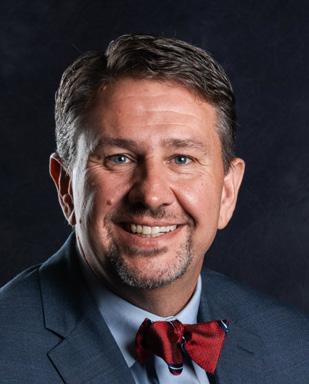
Dr. Josh Brower graduated from dental school in 1997 with Honors from the University of Minnesota before training in the US Army. He is a well known national and international speaker, and received his lifetime achievement award in 2023. He completed law school in 2024 and lives in Texas with his wife Sarah who has an RDH and JD degree. He successfully ran a small multistate multidoctor dental business, and is a lifelong entrepreneur. He is available by his email at browerj@gmail.com or through his website www. getdentaltraining.com



with Anne Du y PODCAST


Wellness
The Man in the Gym Class
By Dr. Alan Stern
I’ve been a gym guy for most of my adult life. Early on, I worked out alone or with a few regulars who showed up at the same time after work. I got stronger, made some friends, and had fun doing it.
Years later, after relocating, I found myself back to working out solo—getting stronger, yes, but also injuring myself at times because I wasn’t training smart or focusing on balance.
Over the last 15–20 years, I’ve had the privilege of working with some great trainers. Still, despite their encouragement, I resisted group fitness classes. The comparison trap had me prisoner. I didn’t want to look foolish in front of more experienced people.
One day, Coach Don, my longest-tenured trainer in New Jersey, finally convinced me to try one of his classes. Lo and behold—I loved it. Before long, classes four times a week became a cornerstone of my fitness journey.
When my wife and I moved to our new home in Florida, the community gym offered excellent classes. So, during my first week, I ventured into an 8 AM class—where I quickly noticed I was the only guy. My unease deepened when Coach Carrie smiled and announced, “Look—we have a man!”
In my awkwardness, I smirked and replied with my usual humor: “Just call me ‘token.’”
That feeling of not belonging lingered for a while. But after a week or two, something changed: my comfort, fitness, and perspective grew. I loved the classes and felt myself getting stronger quickly. Yet conversation was scarce—an occasional “good morning,” but not much more.
Then I remembered: among other things, I’m a speaker. So, I spoke. I began chatting with my classmates—laughing about our exhaustion, asking where they were from, and joking about my New Jersey roots (“the land of the fee and the home of the
bribe” is my standard line). The ice broke, and before long, I was part of the group.
Recently, a few other men joined the classes. Guess who they gravitate toward?
LESSONS LEARNED
That experience reminded me of something I’ve noticed in professional life too: people naturally cluster around what feels familiar. Outsiders can feel excluded—until someone breaks the ice. Which brings me to a few lessons.
THAT DARNED AMYGDALA
Years ago, my friend and Emotional Intelligence coach Dana Ackley, PhD, taught me about the amygdala—the part of our brain wired to protect us from danger. It triggers fight, flight, or freeze when something feels threatening. The trouble is, it sometimes misinterprets “different” as “danger.”
A group of women may feel that when a man enters their circle. And men, too, may feel unsettled when women rise in leadership and influence. My own awkward start in that gym class reminded me firsthand how easily our amygdala reacts to “different.”
WOMEN’S EXPERIENCES MATTER
It’s no secret that for much of history, it’s been a man’s world. Women have had to push through glass ceilings and uneven roads to claim their rightful place as leaders. While progress is real, the ceiling hasn’t completely shattered, and pushback still exists. Women’s caution—or resistance—when a man steps in isn’t without cause.

DIFFERENT PROBLEMS, SHARED CHALLENGES
Men and women are different—we think differently, our lives outside the office carry different pressures, and that’s a good thing. But in dentistry, we also share many of the same stressors: the demands of patients, finances, teams, and professional growth. Those challenges are better addressed when we collaborate and bring our unique perspectives to the table.
TWO WRONGS DON’T MAKE A RIGHT
My mother always reminded me that two wrongs don’t make a right. Yes, the past has been filled with unfairness, discrimination, and exclusion. But the solution isn’t building new walls. It’s creating space where we work together as equals—exchanging ideas, sharing viewpoints, and helping each other become Better, Richer, and Stronger.
MOVING FORWARD TOGETHER
We all have the gift of a prefrontal cortex—our brain’s filter for the amygdala’s quick reactions. If we pause and use it, we can replace fear and division with collaboration and understanding.
Men and women together can create a profession and a world that’s healthier, stronger, and more human.
Let’s bring our strengths, vulnerabilities, and brilliance into the same room. And let’s enjoy the ride we’re all on together.
Enjoy the Ride – Better, Richer, and Stronger
Dr.Alan Stern retired from the practice of Dentistry a and now runs a speaking business called Better Richer Stronger.
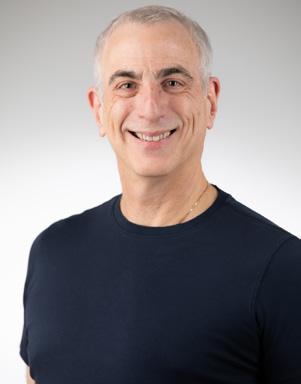
Alan works with dentists who want to create a workplace that is productive & profitable and a life that is rewarding and meaningful. He coaches and conducts presentations for dental groups that redefine what it means to build a better team and rekindle their passion for what matters. He has been named Most Inspiring Dentist and Speaker of the Year

Four Strategies for Dentists to Avoid Financial Burnout
By Lauren Kearl,CPF
On average, people make nearly 35,000 decisions a day ( Psychology Today). For women in dentistry, I’m convinced that number is probably even higher. Between being a mom, partner, community member, practice owner, and dentist, the decisions never stop.
Take something as simple as laundry. It’s never just tossing clothes in the washer. It’s a string of microdecisions: What needs washing right now? Should colors and fabrics be separated? Are there stains to treat? Which detergent, how much, and on what cycle? And when does it all get folded and put away?
Household chores are only one example of how small choices pile up. Each microdecision chips away at your energy, and it’s easy to see why so many women feel mentally and emotionally exhausted. For dental entrepreneurs, the load doubles—treating patients, running a practice, handling payroll, managing loans, and trying to keep up with endless emails. Just like laundry piling up, these decisions add weight over time and quietly lead to emotional burnout.
And when financial stress gets layered on—student debt, fluctuating income, or uncertainty about retirement—the mental drain only deepens. This is where decision fatigue and emotional exhaustion can easily contribute to financial burnout.


WHY FINANCIAL BURNOUT HAPPENS
Women who own dental practices often face financial burnout, largely due to the enormous debt they carry. The average dental student graduates with over $300,000 in student loan debt (ADEA, 2024). In addition, purchasing an existing dental practice can cost between $500,000 and $750,000 (Curve Dental). Many dentists start their careers owing more than a million dollars in loans. By comparison, the typical American household carries around $105,000 in debt ( Business Insider).
Financial burden is only part of the story. Women in dentistry also carry emotional debt, the invisible, ongoing responsibilities that come from juggling multiple roles and meeting high expectations both at work and at home.
Dentists are expected to be real estate professionals, CEOs, and healthcare providers—all skills that are not taught in dental school. Managing these responsibilities at once creates a constant mental load, leaving you drained and restless. It also makes long-term planning difficult because short-term financial pressures push you to make quick decisions that may not align with bigger goals.
Inconsistent cash flow from the business adds to the challenge. At home, budgeting for bills, savings, or major life decisions can feel like guessing. In practice, fluctuating patient counts and case acceptance create similar uncertainty. Deciding when to invest in equipment, staff, or continuing education can feel risky, and
tracking income, deductions, and bookkeeping often consumes time that could be spent on patient care.
Societal expectations often add invisible responsibilities, assigning women the job of managing both home and emotional needs. Even in professional settings, women are frequently expected to organize, anticipate needs, and support others. These roles are not formally recognized or compensated, yet they take a real toll over time.
Carrying both financial and emotional loads affects emotional and physical well-being. It can lead to anxiety, uncertainty, depression, and self-esteem issues. I often hear how the emotional burden brings on sleepless nights. Ultimately, burnout takes away time and energy from the things that really matter, like moments with family and friends.
STRATEGIES TO REDUCE FINANCIAL BURNOUT
Have a Buffer
Having an emergency fund is one of the simplest yet most powerful ways to reduce daily stress and decision fatigue. Without a financial buffer, every slow month or unexpected expense can feel like a crisis, triggering reactive choices that may not serve you long-term.
A healthy buffer breaks the debt cycle by reducing reliance on credit cards or loans during lean periods. It protects your goals and gives you flexibility. You can say no to a bad partnership or

difficult patients because you are not operating from financial desperation. A strong emergency fund typically covers three to six months of personal expenses and one to two months of business operating expenses, kept in an accessible, low-risk account such as a high-yield savings account.
Have a system that works for you
Many people assume there is a “right” way to handle finances, but a financial system should be tailored to your lifestyle, preferences, and goals. What works for one person may feel overwhelming or inefficient for another.
Consider two clients who are equal 50/50 partners in a dental practice. On paper, their finances are very similar, but their financial plans could not be more different because their goals and preferences vary widely. Personalized planning is crucial for avoiding burnout and building a system that actually works for you.
It is better to have a simple, consistent process you can maintain than a complicated system that feels impossible to keep up with. Automating key parts of your finances, such as savings, bill payments, and investments, removes the mental burden of remembering every detail. Start small by automating one bill or savings goal first. Use technology that fits your comfort level, keep a dedicated folder for important documents, and set up alerts for due dates or low balances.
Protect Your Future
Beyond day-to-day management, long-term planning plays a critical role in reducing stress and protecting your future. One of the questions I hear most often from dentists is, “Am I on
track to retire?” Knowing you are on track gives you the power of choice, which can reduce stress and free mental energy for the present.
The earlier you start planning and saving, the more you benefit from the compounding effect of investing, which is when your money earns interest on both your contributions and the interest it has already earned. Confidence in your retirement plan allows you to focus on what matters most, including your work, relationships, and hobbies.
While retirement planning addresses long-term goals, insurance planning provides an important layer of protection against unexpected risks. Dentists face unique risks such as injury, illness, or even a broken hand that could disrupt a practice. Many assume disability insurance is unnecessary, but one in four dental professionals will rely on it at some point. Knowing your income is protected, whether short-term or long-term, can greatly reduce stress and help you feel secure about the future.
Delegating to a Professional
Delegating can feel challenging for those who enjoy being actively involved in many aspects of their work and personal life, but it is one of the most powerful ways to reclaim time and energy. A helpful mindset is to focus on doing only the things that only you can do, and allow others to take on the rest. The time you invest in training someone on the smaller tasks you normally handle will pay off many times over, freeing you to spend more time on what matters most.
I used to think doing everything myself made me stronger and more successful. Now I realize that those who delegate gain something even more valuable: time. We cannot be experts in parenting, travel, accounting, business, dentistry, and friendships all at once.
Delegating may feel uncomfortable at first, but the benefits far outweigh the discomfort. Bringing in an expert frees your time and energy, reduces stress, and allows you to focus on what you truly enjoy. You do not need to delegate everything, but if something is time-consuming, confusing, or not sparking joy, consider letting someone else handle it. This can include CPAs, wealth advisors, practice consultants, travel consultants, or therapists. Be intentional about what you spend your time on and delegate what serves your life better.
PUTTING IT ALL TOGETHER
Financial burnout is real, but it doesn’t have to define your career or life. By creating a financial buffer, building a system that works for you, planning for the future, and leaning on others
when needed, you can reclaim your energy, reduce stress, and focus on what truly matters.
Managing a dental practice and a personal life is a complex job, and carrying both financial and emotional debt can be exhausting. Taking steps to intentionally protect your time, income, and mental health can give you the freedom to make choices rather than react to circumstances.
Small, consistent actions like saving, automating, delegating, and planning compound over time, just like your retirement savings. The sooner you start, the more control you’ll have over your future, giving you more mental energy to free up for your patients, your family, and yourself.
Financial planning is not just about numbers; it’s about giving yourself the space to breathe and the power to choose to give yourself confidence to live your life on your terms. By prioritizing your finances and well-being, you can reduce burnout and enjoy the rewards of your hard work, and thrive as a dental professional and in all the roles that matter the most to you.
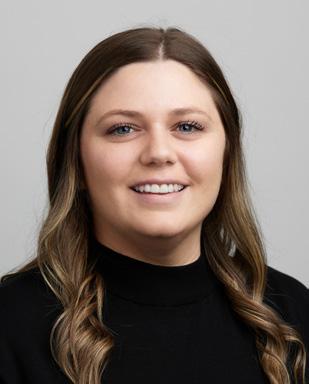
Lauren Kearl is a CERTIFIED FINANCIAL PLANNER™ at Dentist Advisors. With a degree in Personal Financial Planning from the nationally ranked program at Utah Valley University, she provides guidance in areas such as investment strategies, tax planning, debt management, insurance, and financial growth. She is passionate about financial education and empowering others to feel confident in managing their finances. By offering clear and accessible advice, she ensures clients have the knowledge to make informed decisions.
Social Handles
@dentistadvisors - Facebook, Instagram, LinkedIn
www.youtube.com/@dentistadvisors414

We mean it when we say Trusted Expertise, Unrivaled Support.
When you choose Patterson, you can count on the industry’s most responsive sales and service teams. We will listen to understand your needs and goals and offer solutions to meet them. We’ll be there when and where you need us – whether you’re purchasing routine supplies and everyday equipment or breakthrough technology and cutting-edge software. We’ll support your success at every step.
From a $1 Startup to a 350+ Team: What I Learned From Building it the Wrong Way First
How Cory Pinegar built a purpose-driven company that’s redefining support in the dental industry
By Cory Pinegar
THE $1 BET
In 2016, at just 22 years old, I made what I call “the best bad decision” of my life: I bought a struggling dental services company for one dollar. I had no grand business plan, no investors, and no experience running a company. What I did have was grit, curiosity, and a genuine belief that human connection could still win in an increasingly automated world.
Fast-forward eight years, and Reach has become one of the fastest-growing companies in the industry, supporting thousands of dental clinics throughout the years and employing more than 350 people currently. But this journey wasn’t a straight climb. It was a winding path with a relentless pursuit of building something that mattered.
This isn’t a story about overnight success. It’s a story about learning to row in sync with your team, learning to have hard conversations, and figuring out what sustainable growth really looks like.
What I didn’t realize then is that grit alone doesn’t build a business, and that some of the hardest lessons were still ahead.
THE ILLUSION OF SUCCESS
By 2018, from the outside, Reach looked like a breakout success, my name showed up on a couple of “20 Under 20-Something” lists. Inside, we were built like a house of cards.
We were bleeding money. Our churn was way too high and that meant the sales team had to sprint just to keep the company even. Investors and awards were applauding the growth curve, on the other hand, the P&L was screaming for help.
What I have realized is that the root problem was our model. What we had was essentially a big, well-intentioned call center running on guesswork, with no real structure behind it. Quality tanked because no one had time to prep, and costs ballooned because each call was a one-off.
At the beginning, there were three of us as co-founders. We were all smart and driven, but without alignment, we were pulling the company in different directions. Everyone worked hard; the boat just spun in circles. I was conflict-averse, nodding yes when I felt no. Jeff Bezos calls it “disagree and commit.” I was doing “disagree and stay silent”.
Looking back, I can say I wasn’t the leader I needed to be. Clear is kind. Kind without clarity is just a slow way to watch things break. I had to learn that the hard (and very expensive) way.
Eventually, the numbers forced us to stop pretending. We had grown fast, but the foundation was cracking. The model wasn’t scalable. And I wasn’t leading with the clarity the team needed.
So, we made a hard pivot.
We moved away from a fragmented model that only handled scheduling, a setup that simply didn’t work. Instead, we started building something complete, assigning dedicated Virtual Assistants to specific practices. Real people. Fully trained. Fully integrated. The kind of teammate who shows up every day and knows the details that matter, like which insurance the office accepts, which provider prefers which patients, what hours they work.
This shift wasn’t cosmetic. It changed everything: the quality of service, the satisfaction of our clients, and the engagement of our team. It also changed our unit economics. Over time, as we stayed consistent, the math started to work because the model was built for sustainability, not chaos.
Underneath it all, what really changed was this: we stopped chasing vanity metrics and started solving real problems. We stopped trying to look successful and started trying to be useful.
We started being honest, about what was working, what wasn’t, and who we needed to become to build something sustainable.
BALANCE DRIVES SUSTAINABILITY
As we rebuilt the business from the inside out, one belief became clear: lasting success comes from designing systems that provide value to everyone involved.
There’s a phrase I hear a lot in business: people first. I get where it comes from, and I agree with the heart behind it. But I’ve learned that when it comes to building something that lasts, that idea is incomplete.
At Reach, we don’t believe in putting the team above the customer, or the customer above the team. We believe in creating an environment where we can both thrive together. That’s what makes a business resilient over time.
When we shifted to the dedicated Virtual Assistant model, we started designing roles that worked for both the people in them and the practices they served, with structure, support, and a healthy setup. When they’re trained, supported, and embedded into one specific practice, with aligned expectations and mutual trust, everyone wins.
It’s not always easy. Sometimes it means saying no to a clinic that expects more availability than the model can sustainably
support. Sometimes it means parting ways with a team member who resists structure. But that’s the discipline that protects the health of the business.
That’s what real sustainability looks like: a business where the incentives line up, where people do great work because they understand the why, and where clients stay because they feel that consistency every day.
Balance is what creates a long-lasting, healthy business.
LOOKING AHEAD
I used to think the goal was to build a big company. Now the goal is to build a company that solves real problems and takes care of both its people and its clients.
One with no borders, where great people from anywhere in the world can do meaningful work. One where balance holds everything together, creating a sustainable, resilient business that is built to last.
We had to build it the wrong way first, so we could learn how to build it right.
Helping dentists succeed is not just about running a tighter operation. It’s about giving them the breathing room to focus on what they love and helping patients get the care they need. It’s about building workplaces that feel supportive, not stressful.
That’s what we’re doing at Reach. And if we stay committed to the hard conversations, the right systems, and the people who make it all work, I believe we can grow this team to 10,000 strong, without losing what made us special when we were 10.
Because at the end of the day, we’re not just talking about scale, but impact. And we’re just getting started.
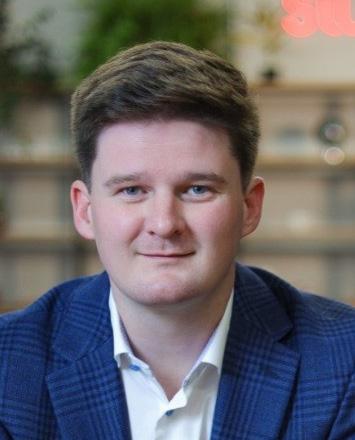
Cory Pinegar is the CEO of Reach, a fastgrowing company redefining virtual staffing for dental practices across the U.S. Since acquiring the company at 22, he has scaled Reach to support thousands of clinics while cultivating a culture of clarity, accountability, and purpose. A passionate advocate for sustainable growth and human-first leadership, Cory also serves on the boards of Verific and the Parkinson’s Foundation.
Lessons From the Professionally Ambitious: Common Themes Among the Industry’s Most Dedicated Leaders
By Thomas Passalacqua
“Thomas, that is a really good question…”
Once I hear those words, I can’t help but smile knowing that things are going well, and we are making great progress. As an executive coach who specializes in helping professionals better reach their goals, this phrase embodies a powerful moment where those I work with are on the verge of achieving a significant breakthrough in the challenges that are holding back their success. It’s a sacred moment where I am guiding them through layers of exploration to overcome a stubborn sticking point, and they are just reaching their capacity to enable a substantial discovery; this is when true growth really happens.
With just the right amount of time and applying a laser-focused process, usually what follows is another profound expression, even more satisfying to hear, as a wave of reassurance washes over them: “Wow, I can’t believe this!” The relinquishment of a longestablished obstacle and landing a relevant and effective solution.
Throughout my programs, I have the honor to work with some of the industry’s most passionate, brightest, and ambitious individuals who are consistently striving to grow and reach a higher level of performance and achievement. It is natural for me then
to observe that there are some similar challenges that we all may experience, as well as similar strategies that can help one best navigate through them.
We all may feel that we are on a unique journey, and our struggles are our own to endure. And while yes, we all are experiencing the world in a particular lens, many of these events are rather ubiquitous and common themes continue to arise. Although we as individuals may respond differently to them, generally we can navigate them in a similar manner to overcome the challenge or manifest the desired change.
Here are a few of those challenges and solutions that our fellow colleagues navigate which may be quite relevant and familiar to many of you.
GAINING CLARITY ON ACHIEVING OUR GOALS.
A common topic that often comes up for a variety of ambitious professionals is a general sense of unclarity on how to achieve a specific goal or how to accomplish a task. The drive and purpose are there, but the logistics on how to execute it are not yet established.
What specific actions do you need to take that will get you closer to your goal with the least amount of resistance and the highest likelihood of being successful?
I often witness where one wants to get to a certain endpoint but isn’t yet confident or clear about how to get there.
Throughout the process, we discover relevant resources one can use to close this knowledge gap:
• Identifying the most important information needed to start to achieve that goal
• Pair a specific action and timeline that enables execution
• Ensuring that accountability measures are in place
Before many of these action items are even established, getting laser-focused on exactly what the goal is in the first place is vital. Identifying the true goal and envisioning precisely what you want to achieve is half of the workload needed to accomplish that very goal. The rest is just relevant execution and tracking progress.
Challenge yourself to identify the true sticking points that may be giving you resistance and strategize on how to best overcome them. How can you then close your knowledge gap when you don’t have anyone or any means to supply you with the precise knowledge that you need? You’ll need to create systems and an approach to source that information organically and then analyze the process to determine if you are on the right track.
NAVIGATING DOUBT AND IMPOSTER FEELINGS.
One of the most frequently identified topics when speaking with high performers are the feelings of doubt and inadequacy. Within a wide range of various roles and positions, nearly everyone, at some point, expresses difficulty truly believing in themselves or expresses hesitation when making decisions or plans for their achievements. Many of these individuals openly confess they have these doubts, and the solution to overcome them generally is beyond their vision. However, we can usually lessen these doubts with the following guided process:
1. We aim to identify precisely what that doubt is
2. Gain proof from your past experiences that you are already competent and reassure you that you are in fact capable
3. Being as objective as possible without feeling the need to default back into a familiar emotional safety zone
We often experience being a victim of our emotions and this clouds our objective vision to best perform and execute our tasks; we usually see that it’s ourselves standing in our own way.

So, how do we break free of that challenge? We get specific, and we get active. We work to objectively identify what precisely is affecting us and causing that doubt. Then we establish realistic actions we can easily take that will help us move forward. Finally, recognize what is working and repeat the process.
Overcoming imposter feelings becomes an operating system, not a battle of emotions. We’ll work to identify effective tasks, strategies for completing them, tracking the results, and neutrally recognizing that the results were due to those specific actions. Just by simply realizing that the more you separate yourself from emotional reactions and act more objectively empowers you to make progress. Next time you question your abilities, ask yourself “Is this true or just my emotions getting the best of me?”
MANAGING OVERWHELM.
In this modern age, with all of our responsibilities, stress, and ambitions paired with the unique time that the world is in, it is no wonder nearly all of us can say we’re overwhelmed. An effective method for cutting through this noise is to keep in mind the very priorities you have at the moment and how your near-term actions and activities support your long-term goals. Managing overwhelm is a matter of constant prioritization, not a challenge to push yourself to the brink and see how long you can endure discomfort. Here are some common habits that I hear could help many of us:
• Aligning your internal drive and passions with the purpose of your work
• Consistency beats intensity: needing grit to continue to drive forward even though you may be unclear on where you’re going
• Having tenacity and resilience to continue to press on will help break through moments of uncertainty
So, what can one do if they find themselves feeling overwhelmed, stressed, doubting their abilities, or just too busy to even start thinking of strategies? Generally, one key ingredient that many of us forget to incorporate when we operate at such high capacities, would be intentional attention. It’s taking focused time to think
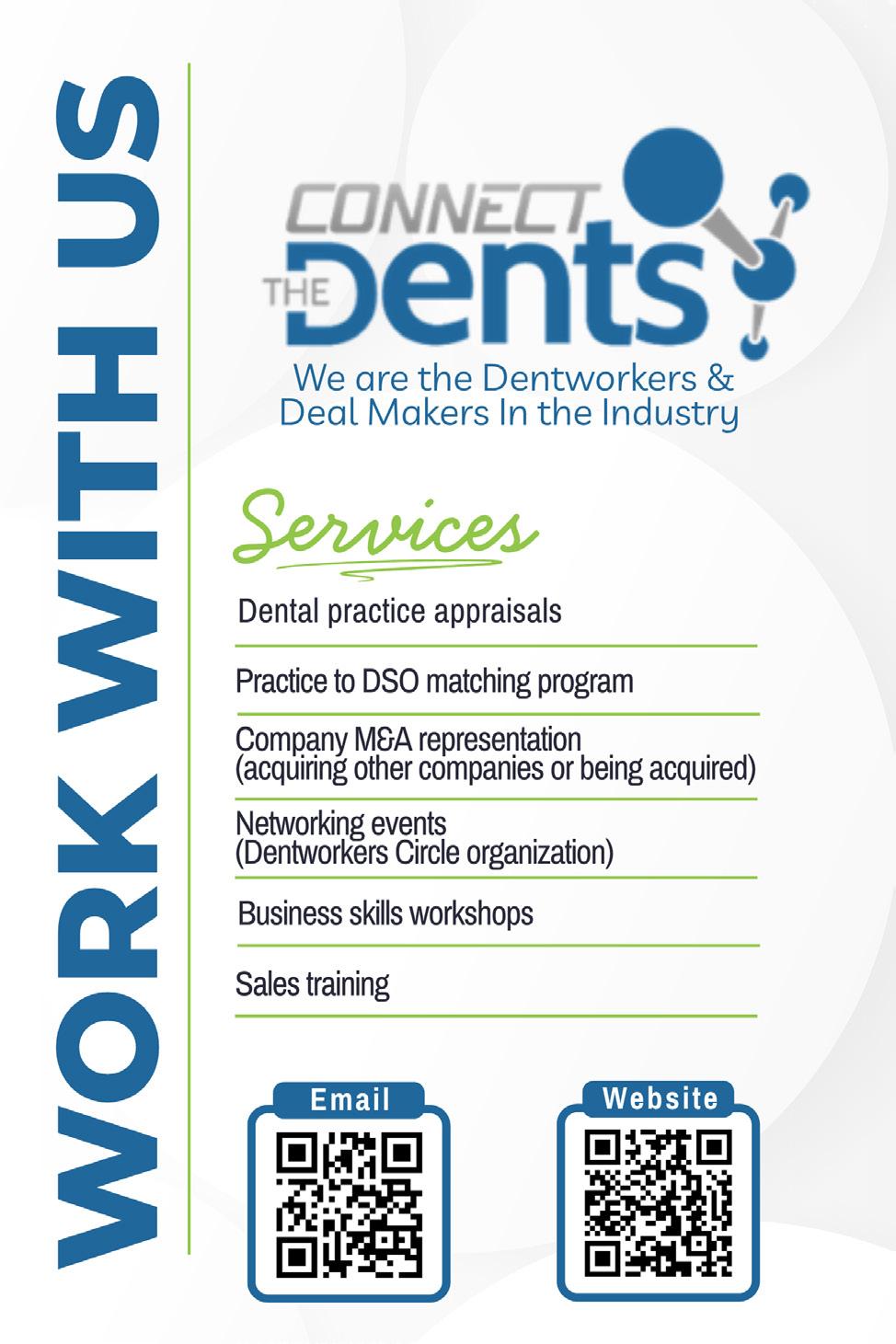
and create space to identify and work through what is preventing you from operating more efficiently. Homing in on these specific issues and sourcing effective solutions to overcome those very problems will enable compounding success. Even after just a few minutes of deliberate navigating, one usually sources a variety of solutions or a significant method to better achieve their goal.
Another familiar solution that many people often mention helps them is having community or an advocate to gain a different perspective. Having someone to be a sounding board, someone to console you, someone to challenge your process and share another view can provide so much more clarity and reassurance than you ever can get on your own. Who can you identify that you could speak with and would be willing to listen and offer support?
My approach as an executive coach focuses on having one digging deeper and internally reflecting to uncover more layers of oneself. The goal is to explore solutions they haven’t yet considered. It’s a precise process, and I am honored to enable the growth and success of those I work with.
These common experiences are just some of the most prevalent challenges that many of us in this industry are facing. Perhaps the accompanying solutions are as applicable to those who can relate to these struggles. My mission is to empower the success of others, and I hope some of these examples can provide you with reassurance that there are effective strategies to better achieve our goals.
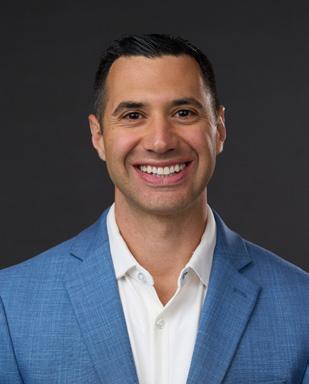
Thomas Passalacqua is a certified Executive Coach and specializes in customized professional & leadership development. With a master’s degree in education, Thomas started his career as a founding teacher in New York City and then transitioned into dental sales where he was an award-winning consultant who trained and mentored other sales professionals. Currently, Thomas is the director of business development for a growing group practice in the northeast. In his executive coaching and training platform, Ascend Professional Pathways LLC, he works with a variety of industry professionals to better navigate their challenges, maximize their success, and empower them to best reach their goals.
LinkedIn: https://www.linkedin.com/in/thomaspassalacqua/ Website: https://ascendpropathways.com/
From Dining Room Table to Nationwide: How I Built a Remote Dental Billing Company on Connection and Clarity Business
By Crystal Eudy
FINDING CLARITY IN CHAOS
When the world shut down in 2020, I found myself at my dining room table with a laptop, a cup of cold coffee, and a determination to turn uncertainty into opportunity. My journey into dental billing began much earlier — in 2008, right after transitioning from medical billing. I worked in a dental office doing insurance verifications. I would print codes and take them home to study, memorizing dental terminology like mesial, distal, and tooth numbers late into the night. What began as curiosity and necessity soon became a deep understanding of the dental industry, from X-rays to revenue cycles.
Over the years, I worked my way up — from front desk roles to office manager, revenue cycle manager, and beyond. Each position taught me something invaluable: attention to detail, empathy for patients and teams, and the importance of communication. These lessons would later become the backbone of my company, Crystal Clear Billing Solutions, but back then, it was simply me and the drive to learn everything I could about dental billing.
WHEN COMMUNICATION FAILS, EVERYONE PAYS
By 2020, I was working at a dental office while also contributing part-time to a large remote billing company. I quickly realized the gap between corporate promises and real service. Commu-
nication was poor, accountability was low, and offices were left to bear the brunt of mistakes or confusion. It was frustrating to watch offices pay for services that treated them like numbers in a system, with no one-on-one support. I knew it didn’t have to be this way.
The frustration became my motivation. I wanted to create a company that did it differently — where offices felt seen, supported, and understood. I wanted to provide a billing service that was not just about processing claims, but about building relationships, solving problems, and empowering dental teams to focus on patient care while knowing their financial operations were in capable hands.
BUILDING SOMETHING DIFFERENT
Launching my company was an exercise in endurance and vision. Working 12- to 14-hour days, I focused on mastering the details that many companies overlook: accurate billing, prompt claim submissions, and clear communication. I wanted every client to feel like part of our team, even though our work was remote.
Unlike large corporate billing companies, we prioritize one-onone service. Every office gets a dedicated billing specialist who handles their entire revenue cycle, ensuring consistency, quick issue resolution, and a deep understanding of each practice’s needs. Each member of our team has at least 12 years of dental
Hope Returns to Dry Mouth Care: How Aquoral’s Comeback Is Redefining
Xerostomia Management and Practice Differentiation
By Bennett Blakeman - CEO of K Pharmaceuticals
Bridging Medicine and Dentistry: The XPERT Certified Provider Program unites medical and dental professionals in a shared goal: to identify, manage, and relieve xerostomia through education and collaboration. By aligning care across disciplines, we move beyond symptom treatment toward whole-patient health. Because when we elevate providers, we elevate patients.
For too long, dry mouth has been dentistry’s quiet epidemic— impacting speech, sleep, and smiles—while most patients are told to “drink more water.” But a clinically proven innovation once thought lost is making a comeback. Aquoral’s return isn’t just about relaunching a product; it’s about restoring relief, redefining xerostomia care, and giving practices a way to make compassion scalable.
THE HIDDEN TOLL OF DRY MOUTH
Dry mouth—or xerostomia—can be more than a nuisance. It disrupts nutrition, fractures speech, increases caries risk, and causes painful mucosal injury. Among patients burdened by polypharmacy, Sjögren’s syndrome, cancer therapies, and CPAP
use, the condition can be relentless—and quality of life can plummet.
When this product disappeared from pharmacy shelves years ago, patients didn’t just complain. Many cried. For some, this lipid-based oral spray was the only solution that gave lasting relief. Those stories became the catalyst for its relaunch.
A THERAPEUTIC REBORN
In 2023, Aquoral Protected Oral Spray re-entered the market— reclaiming a therapy that had quietly changed lives before being discontinued by larger corporations. Its comeback isn’t commercial; it’s restorative.
This mechanism is simple yet powerful: a proprietary oxidized glycerol triester (OGT) complex that forms a long-lasting protective film across oral tissues. Unlike water-based rinses that evaporate, it resists desiccation, locks in moisture, and supports mucosal healing for up to six hours per use.
When patients describe a product as “life-changing,” clinicians should take note.
“When relief disappears, patients don’t forget. Neither should we.”
FROM ONE-SIZE-FITS-ALL TO PERSONALIZED CARE
Inside Dental Hygiene recently spotlighted the Personalized Xerostomia Protocol (PXP)—a structured, patient-centric framework that replaces guesswork with graded care. PXP encourages clinicians to:
• Screen for early signs of salivary dysfunction, even in asymptomatic patients
• Grade severity using tools like CODS or xerostomia inventories
• Escalate systematically: hydration → stimulants → barrier therapies → advanced options
The goal: treat early, personalize therapy, and normalize xerostomia management as standard practice.
WHY THIS MATTERS FOR DENTAL ENTREPRENEURS
Xerostomia is one of the most underdiagnosed yet high-impact conditions in dentistry. Addressing it isn’t just good medicine— it’s good business.
• High-need, low-saturation: Up to 30% of adults experience xerostomia, yet fewer than 10% of practices have a structured management protocol.
• Low-barrier differentiation: Offering xerostomia management positions your practice as medically advanced without adding operational complexity.
• Cross-referral opportunity: Collaboration with oncology, sleep, and rheumatology providers can open new patient channels.
• ROI through empathy: Comfort-driven care builds loyalty, retention, and reputation faster than any cosmetic add-on.
EMPOWERING THE PROVIDERS WHO MAKE RELIEF POSSIBLE
True innovation isn’t complete without education. That’s why the XPERT Certified Provider program was created—to rec-

ognize hygienists and dental professionals who complete the Xerostomia Prevention, Evaluation & Relief Training.
This initiative does more than certify; it uplifts. It’s designed to elevate clinicians, strengthen their ability to deliver personalized xerostomia care, and give back to the providers who make comfort possible every day. Each certified participant joins a growing network of professionals advancing xerostomia management as both a clinical standard and a practice differentiator.
Because when we elevate providers, we elevate patients—and that’s the real metric of progress in modern dentistry.
POSITIONING AQUORAL WITHIN THE PXP FRAMEWORK
Tier Intervention
1 Lifestyle & behavioral (hydration, humidity, sugar-free gum)
2 Sialogogues (pilocarpine, cevimeline)
3 Lipid-based barrier therapy
4 Advanced therapies (regenerative, gene, device-based)
Role of Aquoral
N/A initially
Use concurrently—enhances comfort and compliance
Primary intervention when prior tiers fail
Adjunctive support
Incorporating Aquoral transforms xerostomia care from a checkbox to a differentiator—where comfort meets conversion.
THE HUMAN SIDE OF SCIENCE
Clinical metrics matter, but patient stories move hearts. Relief from xerostomia can mean enjoying a meal again, speaking without pain, or sleeping through the night. For some, Aquoral restored more than moisture—it restored dignity.
As one practitioner put it:
“When Aquoral disappeared, my patients begged for it. When it came back, they hugged me.”
That kind of response reminds us why we do what we do.
CHALLENGES AND FUTURE DIRECTION
Despite strong evidence and patient demand, adoption still faces hurdles:
• Reimbursement inertia: Many formularies still default to outdated water-based rinses.
• Guideline lag: Major associations need to update protocols to reflect lipid-based innovations.
• Awareness gap: Many general practitioners and hygienists still underrecognize xerostomia’s impact.
But as personalized care becomes dentistry’s new frontier, these barriers represent opportunity.
THE BIGGER PICTURE
Dentistry is evolving beyond restoration—it’s entering the era of function, comfort, and quality of life. Pairing these technologies with frameworks like the PXP allows clinicians to not only relieve symptoms but to set a new standard of proactive, patientcentered care.
Relief is back — and so is opportunity. To learn more about integrating Aquoral into your xerostomia management program, obtaining certification, or exploring educational partnerships, visit www.aquoralspray.com/dashboard or contact info@kpharmaceutical.com.
When patients say, “I finally feel normal again,” that’s not a side effect. That’s success.
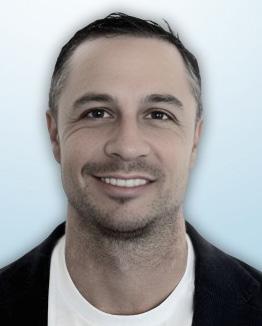
Bennett Blakeman’s background in healthcare management and entrepreneurship led him to the role of CEO of K Pharmaceuticals, a pharmaceutical/medical device start-up. He spearheaded the international manufacturing of the company’s product, Aquoral, a patented lipid-based solution to treat xerostomia focused on audiences to both dental and medical professionals to ensure all patients had access. Privately, as the proud co-founder of the Queen B Foundation, a 501c3 organization dedicated ALS, Bennett and family have raised over $3 million.
K Pharmaceuticals kpharmaceutical.com Aquoral aquoralspray.com 630.319.0778
(Continued from pg. 27)
billing experience, a standard few other billing companies require. We limit client intake to provide focused, personalized support because quality always comes before quantity.
FROM DINING ROOM TABLE TO AUTHORIZED VENDOR
What started as a solo venture has grown into a thriving national business. Today, we partner with dental offices across the country, employ talented billing professionals, and collaborate with industry leaders. One of our proudest milestones is becoming an authorized Open Dental vendor, a recognition of our expertise and commitment to excellence.
Every step of growth — from hiring employees to partnering with industry leaders — has been guided by our core principles: transparency, reliability, and dedication. These aren’t just marketing words; they are standards we live by every day.
LEADERSHIP THROUGH CLARITY
Building a company from scratch after a global crisis taught me more about leadership than any job title ever could. Leadership isn’t about hierarchy or authority — it’s about communication, integrity, and empathy. In dental billing, as in life, success comes from empowering others, building trust, and showing accountability at every step.
For women in dentistry and healthcare entrepreneurship, my message is simple: don’t wait for someone else to fix the system. If you see a gap, problem, or inefficiency, lean into it. Use your expertise, work ethic, and vision to create solutions that others will follow. Leadership starts with action, and clarity — in communication, purpose, and values — will always set you apart.
CLARITY ISN’T JUST IN OUR NAME
Reflecting on this journey, I am grateful for the challenges, long nights, and uncertainties. They shaped not just the company, but who I am as a leader and entrepreneur. Crystal Clear Billing Solutions isn’t just a billing company; it’s a testament to resilience, dedication, and the power of putting people first.
Every office we serve, every claim we process, and every relationship we build is a reminder that success is not just measured in numbers — it’s measured in trust, clarity, and the ability to make others feel supported and valued. And that, to me, is true leadership.
Crystal Eudy turned long nights of studying dental codes at her dining room table into Crystal Clear Billing Solutions, a nationwide remote dental billing company. With over 20 years of combined billing experience, she leads a team of specialists with 12+ years each, dedicated to clear communication and personalized service. Crystal is passionate about helping dental offices maximize revenue while building trusted, long-term partnerships rooted in accountability and compassion.

Connect with Crystal Clear Billing Solutions: https://www.facebook.com/CrystalClearBillingSolutions https://crystalclear-billingsolutions.com
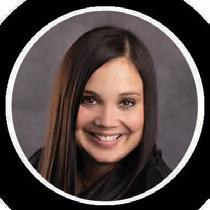

As more practices are shifting away from PPO


Katie Franklin Director of Business Development DeW Member
Beyond the Chair: How Dr. Kylie Schlesinger Is Bridging Dentistry and Dialogue
By Dr. Luke Shapiro, DDS
Ihad the pleasure of interviewing Dr. Kylie Schlesinger, the creator and co-host of Medical Morons, a podcast that delves into the various aspects of private practice and business in dentistry, medicine and beyond. Dr. Schlesinger went to undergrad at University of Michigan, then to the University of Pennsylvania for dental school, followed Columbia University for her orthodontics residency. She graduated in June of 2025 and is now in New York City, working as an orthodontist at various practices. She is a real up and comer in dentistry! She just hosted her first in person event for the Medical Morons podcast and has a lot more planned as she makes her mark in the profession!
Dr. Luke Shapiro: So did you always know you wanted to do orthodontics?
Dr. Kylie Schlesinger: I think so. If I’m being totally honest, I didn’t really know what dentistry was when I went to dental school. I didn’t realize it was so artistic in every little detail. I like science and I didn’t really know what I was getting into. So when I started exploring specialties, I’ve always liked working with kids. I liked the problem-solving aspect of it. I’m a big Sudoku crossword type of girl. The more I looked into ortho, I just found it more and more interesting.
Love it! And as for Medical Morons, is this your first podcast?
Yeah, definitely my first podcast.
How did you learn to do everything? The editing, the logo, etc.? Did you teach yourself?
Lots of learning! A lot of trial and error, and some of it, we still don’t have it figured out. I feel like the audio is probably not amazing, but good enough that people can listen. With ChatGPT, you can figure out anything you want to do. So I just looked up the most basic but effective ways that are low cost. We don’t want to be putting in tons of money into this yet. I started editing with GarageBand back in the day. Then, I found Riverside. I would just see podcasters with the microphone and the headset. Sometimes I don’t even know why I’m doing certain things, but that’s what I saw on the internet, so I’m doing it and learning that way.
So, what’s your current setup now?
We use Riverside, but we record on Zoom because any time I’ve tried to record on Riverside, there are buffering issues, and I would always run into problems. And the other person doesn’t know what Riverside is, so we just record on zoom and I edit on Riverside.
And how much do you edit or cut out?
I cut it thoroughly. We record for usually an hour. I try to make it for 45 minutes, but you get lost in conversation, and I don’t want people to feel like they’re on a time crunch. I try to aim
for 35 minutes of interview content, and then I have the intro and stuff like that, so it ends up being 37 to 38 minutes.
What do you do with all this extra footage? Is there a behind-the-scenes?
People aren’t really missing out on anything that interesting. I will just summarize the bio. Part of why I created this podcast is because there’s so much content out there. So much to sift through. I don’t want people to listen and zone out easily. So, that’s why I’m cutting things out. Not that I think anyone’s saying anything not interesting, I just want them to be as engaged as possible.
So how long does it take you to do all this?
My dad and I meet beforehand for 15 minutes. We actually just tried to change it up, so now we’re trying to talk before and have a little bit of our catch-up banter beforehand, because we’ve gotten feedback that people like to see our relationship, which is hard to capture during the episode because we want to focus on the guest. And then we do the interview, and then afterwards we chat for another 5 minutes about the interview. I put that at the beginning of the episode to give listeners a taste of what the interview is about. I’ll edit during lunch at some of my jobs or if a patient doesn’t show. I would say 4-ish hours throughout the week. It’s not an impossible amount of time. It’s definitely a lot of extra work, and that’s why I only upload every two weeks.
Would you have thought in high school or college that you’d be a dental podcaster?
KS: No, no, I don’t even think podcasts were a thing then. What’s great about it is that I’m not producing the content, the guest is producing the content. I’m not just doing this because I’m trying to gain followers or something. I told my dad in the beginning, “Look, if no one listens to our podcast besides mom and our friends, I’ll learn a ton about having to own a private practice or be in business in healthcare, which is ultimately the whole purpose of this, and if people listen, that’s great.”
I like to talk about my experiences, so it’s kind of like a win-win for the most part, and the people who are spread too thin don’t answer me or say no. It’s a good way to just get your name out there and kind of be active in the community.
What is your relationship like with your dad? Do you guys do stuff like this?
So, we’ve always been very close, but he was a corporate lawyer. He would come home late at night, email people throughout the weekends and things like that. He just didn’t have time for projects, and I was also a teenager and not looking for that. So

when he was retiring, that’s kind of when I had the idea, because I don’t have enough business experience to even ask some of the right questions. I don’t even know what I don’t know. So I wanted him to kind of offer that other perspective, and it was just a fun thing for us to do together and learn together.
The podcast event you organized was amazing. Do you have a history of organizing events? Or are you just naturally good at that?
I don’t, but I’ve always liked projects, like having an idea, and then seeing it come to fruition. In dental school, I created a mentorship program with Julie Bereblum, one of my closest friends. We basically facilitated dental students and West Philadelphia high school students to be a mentor and a mentee to each other. We had all these students who were eager to get out into the community. We saw a need for students at West Philadelphia High School. It ended up being about 80 mentors.
I’ve always just liked the result. I selfishly want to see how it happens, so I don’t like to just be involved in something without seeing an effect, I guess. I want to see it from beginning to end.

So it sounds like, to me, you’re going to do a dental startup.
I don’t know, because after interviewing all these people about private practices, I used to say 100%, I’m gonna be a private practice owner. I’m now kind of 50-50. I just think with DSOs, the industry’s changing a lot, and the people who are really successful are the ones who are all in. They’re spending all their weekend time, at night. After dinner, they’re not spending time with their kids as much because they’re trying to focus on this. It’s just something that I’m thinking about more, rather than just jumping into it like I initially thought I would.
What about for the podcast? What goals do you have for the future?
I don’t know yet. Right now, I’m just starting my career, so that’s really my first priority. Learning as much as I can as an orthodontist, getting practice, getting hours in. Eventually, maybe, if we could have a little more of a team, someone that could edit, we could crank more episodes out.
THINGS TO DO, PLACES TO GO
DeW Life Retreat
November 13-15, 2025 Charlotte, NC
American Academy of Implant Dentistry Annual Conference 2025 November 12 – 15, 2025 Phoenix, AZ
Greater New York Dental Marketing
November 28 - December 3, 2025 New York
AAOM Dental Implant Conference
December 4 - 6, 2025 Chicago, IL
AAOMS Dental Implant Conference 2025
December 4–6, 2025 Chicago, Illinois
Yankee Dental Congress 2026
January 29–31, 2026 Boston, MA
Hawaii Dental Association Convention 2026
January 14-16, 2026 Honolulu,HI

Dr. Lucas Shapiro is a graduate of Washington University in St. Louis and Stony Brook University School of Dental Medicine, where he received his Doctor of Dental Surgery. He completed his postdoctoral orthodontic training at Tufts University School of Dental Medicine. He is the owner of Wall Street Orthodontics in NYC. He started the Instagram page @futuredentists , works with the educational organization @ignitedds, and has an orthodontic tiktok page @drshap
Nashville Dental Festival & Conference 2026
January 16th –18th, 2026 Nashville, TN
Rocky Mountain Dental Convention (RMDC)
January 22–24, 2026 Denver, CO
We’d love to see you!


Your Practice Isn’t Falling Apart—Your Systems Are
By Angela Davis-Sullivan, EFDA
You wouldn’t build a house without a foundation, right? So why are so many dental practices trying to grow without solid systems holding them up?
In my book Coming Home to a Better Practice, I talk about systems as your load-bearing support—the beams and bones of your practice. They’re not flashy. They don’t always get a thank-you card. But when things go sideways—patients wait too long, your team misses follow-ups, money leaks through billing cracks—it’s the systems (or lack of them) that determine whether your practice bends… or breaks.
Here’s the kicker: Most problems that look like “people problems” are really “system problems” in disguise. It’s not that Audrey at the front desk doesn’t care—it’s that Audrey is working with duct tape and a wish instead of a clear process. Defects are often found in the system, not the person.
EVER FALLEN INTO THE MYTH OF “JUST WORK HARDER”?
Let’s call this out for what it is: toxic hustle culture. If your team’s answer to chaos is to hustle harder, faster, and longer, it’s time to wave a big red flag. Burnout isn’t a badge of honor—it’s a blinking neon sign that your systems are broken or missing altogether.
Good systems should take weight off your team—not pile more on. When they’re weak, your team becomes the Band-Aid. When they’re strong, the system carries the load and frees your team to do their actual job—not constantly play fire marshal.
Let’s stop glorifying the grind. Systems aren’t about micromanaging or stripping creativity—they’re about predictability. They’re the difference between everyone flying blind and a team working off the same game plan.
5 SIGNS YOUR SYSTEMS ARE FAILING YOU
If you’ve been thinking “this is just how it is,” think again. Dysfunction might be hiding in plain sight. Here are five red flags:
• You’re solving the same problems every week. That meeting about the phones? Again? Yep, that’s a system issue.
• Your rockstar employee is the only one who knows how things work. If they get sick or take vacation, it’s chaos. That’s not a system—that’s a liability.
• You constantly need to “put out fires.” Emergencies shouldn’t be your business model.
• No one’s sure who owns what. If ownership is unclear, accountability disappears.
• Training new team members feels like starting from scratch every time. You’re not onboarding—you’re winging it.
Sound familiar? Don’t beat yourself up. Awareness is step one.
HERE’S WHAT BUILDS REAL SYSTEMS
These three ingredients will make or break your operational backbone:
CLARITY
If your systems aren’t written down, they don’t exist. Period. Saying, “Oh, we all just know how to do that” is not a strategy— it’s a setup for inconsistency. Clarity means your team has a clear map, not a riddle.
CONSISTENCY
Systems are habits, not hopes. A great system used inconsistently is just a broken promise. If you say you follow a protocol—but only when you remember—that’s not a system, that’s chaos.
COMMUNICATION
Even the best systems fail if no one talks about them. Systems need to live out loud. They should be reviewed, refined, and reinforced regularly. If your team doesn’t feel safe giving feedback, the system isn’t serving them—or you.
ACTION STEPS TO STRENGTHEN YOUR LOAD-BEARING SYSTEMS
Ready to fix the leaks? Start here:
• Audit your chaos. Identify recurring headaches and hotspots. If it’s annoying, it’s probably a system problem.
• Document your core workflows. From scheduling to sterilization—write it down.
• Assign system owners. Someone needs to drive the bus—not just ride it.
• Make it visual. Use checklists, whiteboards, or digital dashboards—whatever helps your team see the path clearly.
• Schedule a monthly system check-in. If it’s not on the calendar, it doesn’t exist. This is your preventive care.
BUT WHAT IF IT FEELS OVERWHELMING?
Here’s the truth bomb: You don’t need to fix everything overnight. In fact, trying to will only guarantee burnout. Start small. Win one system at a time. Small improvements done consistently will beat one giant overhaul every day of the week.
And your team? They want to win. They want to know what “right” looks like. They want to stop feeling like they’re in survival mode every Monday. Solid systems are what give them that stability.
This isn’t about adding more. It’s about taking back control. You didn’t open your practice to become an air traffic controller for overdue claims or the official detective of “Who dropped the ball this time?” You opened it to lead with purpose, serve your patients, and have a life outside your office.
LET’S WRAP THIS UP
If this article feels like I’ve been secretly watching your team meetings—relax, I haven’t. But you’re not alone. Most dental practices are standing on shaky scaffolding and just hoping it doesn’t collapse, and we all fall. Let’s do better than hope.
Let’s build something that holds. Something that lifts your team, your profits, and your peace of mind. Systems aren’t sexy—but they’ll save your sanity. And that, my friend, is darn sexy!
Angela Davis-Sullivan is a powerhouse in dental practice growth, blending 30+ years of hands-on experience with bold, results-driven coaching. From chairside to C-suite, she’s done it all—and now helps dental teams and leaders rise to their full potential. A dynamic speaker, published author, and trusted voice in top industry publications, Angela transforms practices from the inside out. Her mission? Build strong systems, grow confident leaders, and turn chaos into clarity with heart, humor, and grit.

Empowering Dental Leaders. Transforming Practices. Delivering Results.

By Allison Lacoursiere
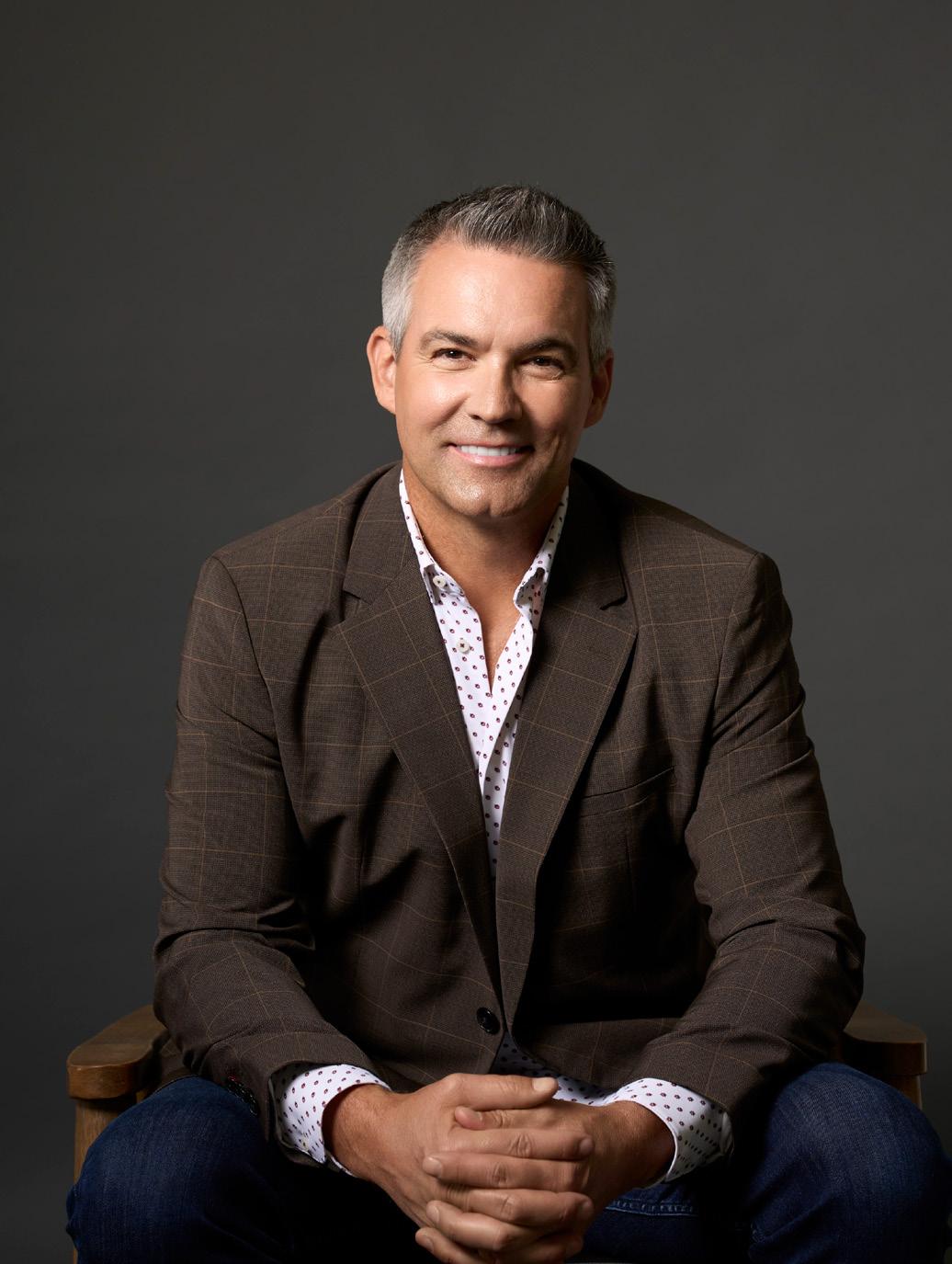

Together, we’ve helped over 16 MILLION kids and their caregivers receive oral health services and learn about the importance of having a healthy smile. See what we accomplished this year and all the ways you can join us in the year to come at ATKids.org.



